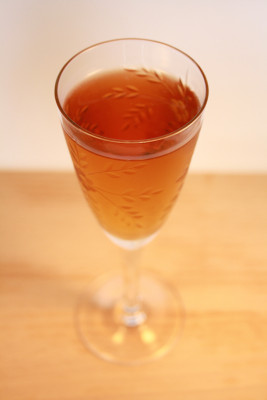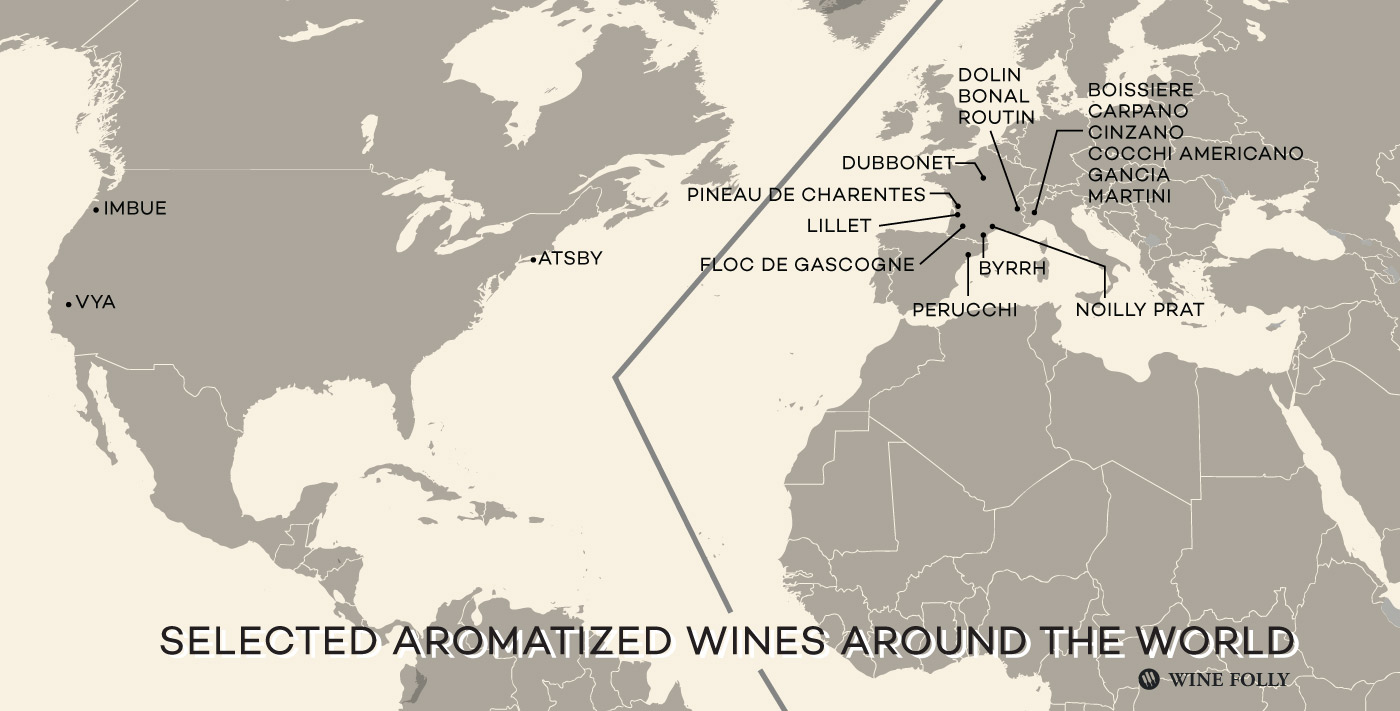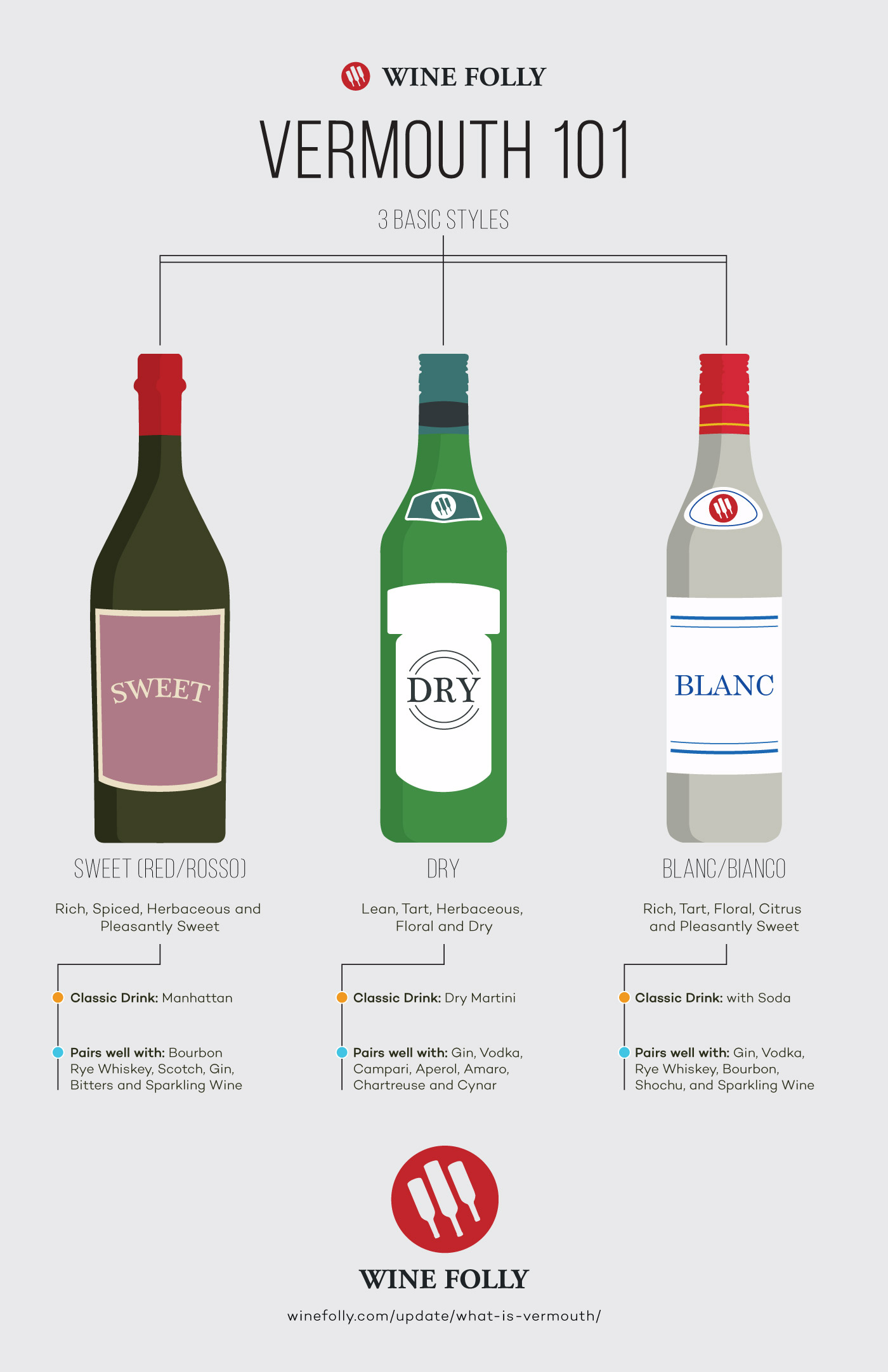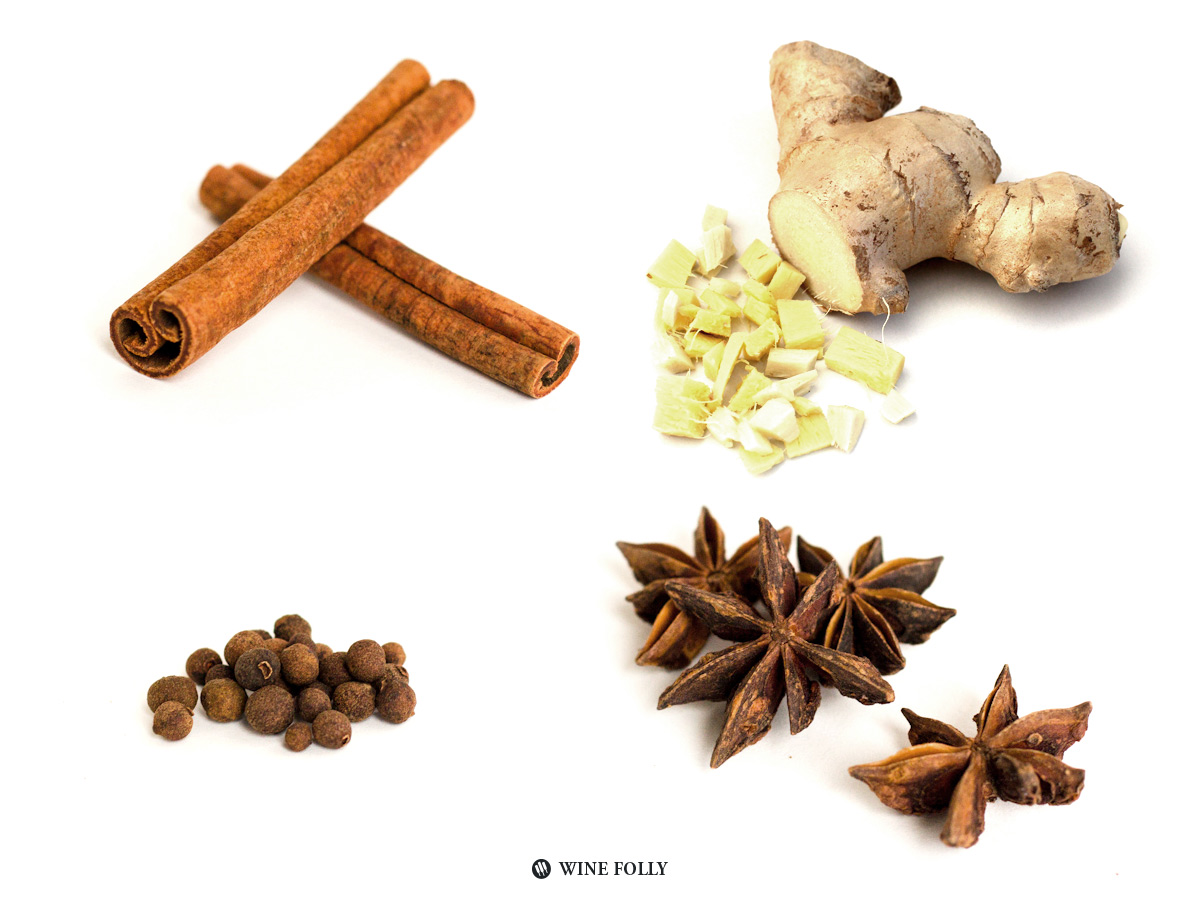What is Vermouth?
Vermouth is an aromatized wine that includes wine, botanicals, some sugar (or grape juice) and spirits–to fortify the wine. It is the use of botanicals which include herbs, spices, and bitter roots that make Vermouth unique. Vermouth was considered a spa beverage that was good for the health during centuries past due to several of its bitter ingredients. We can pay homage to the city of Turin (Torino) in Piedmont, Italy for making Vermouth an important beverage used in cocktails and as an aperitivi and digestivi.
This article will provide the essentials of what Vermouth is and also identify several other wine-based aperitifs to know. It’s an exciting time for vermouth, as many new brands and styles have been introduced.
Styles And Uses of Vermouth
Today, vermouth is primarily used as a blending ingredient in cocktails and over the last 2 centuries 3 dominant styles have emerged:

- Sweet Vermouth: a sweet red vermouth
- Dry Vermouth: a dry white vermouth
- Blanc Vermouth: a sweet white vermouth
Each of these styles have a different purpose and use in cocktails and each Vermouth brand offers a unique interpretation and flavor of each style. Thus, it’s common to see high-end cocktail bars select a Vermouth brand preference or offer a variety to choose from (or, in rare cases: make their own).
Today, with a little searching you can also find two new styles: a golden vermouth (d’Oro) and a rosé style (Rosato).

How to Enjoy Vermouth
Vermouth ranges widely in taste depending on style and producer. There are, however, four basic components that define vermouth’s taste profile: bitterness, sweetness, acidity and, most importantly, its botanical profile. In terms of enjoying Vermouth, even in the 1800’s it was rarely enjoyed straight. The addition of bitters, vanilla, soda or tonic is common to create an enticing drink that would embellish Vermouth’s taste profile. Of course, Vermouth is even more popular as a component in cocktails where it can add a subtle floral note to a Martini or a lovely spiced element to a Manhattan. If you’re interested in simply enjoying Vermouth to really taste it, try it added to soda with a twist of lemon or orange.
How Vermouth is Made
Fundamentally, vermouth is required to be 75% wine which is typically from white grapes and the remaining portion is a blend of sugar (or mistelle: grape juice plus alcohol), botanicals and alcohol. The blends of botanicals and the selection of wine differs according to the producer’s exacting (and closely guarded) recipe. Today’s top Vermouth brands, such as Martini and Rossi or Dolin, were originally developed in the 1800’s and their recipes are protected much like the recipe for Coca-Cola (which by the way, is essentially a non-alcoholic derivative of Vermouth).
Essentially, you take the wine, add sugar or mistelle (which is made by adding alcohol to fresh grape juice), add a botanical distillate blend, and then add alcohol to bring the concoction up to the proper ABV. Vermouth ranges from about 16–22% ABV with most between 18–20% ABV.
Botanicals Used in Vermouth
The defining process of vermouth is the botanical blend. All vermouths contain an artemisia (bitter plant or root) which gives vermouth its fundamental bitter taste. Botanicals are extracted either with maceration (putting them in alcohol and water) or distillation (distilling alcohol through a basket of herbs). Producers frequently use dozens of different components to create vermouth and often mention this on the label such as: “A blend of 33 botanicals.”
Here is a list of common botanicals used in vermouth:
- Bitters: cinchona bark (quinquina/quinine), sweet flag, licorice root, cascarilla, wormwood, angelica root, oris root
- Citrus: orange peel, lemon peel, lime peel, bitter orange, bergamot orange peel, pomelo peel
- Herbs: juniper, oregano, lavender, roman chamomile, dittany of Crete, orris root, gallic rose, angelica, marjoram, hyssop, ginger, coriander, st. john’s wort, honeysuckle flower, kieffer lime leaves, sage
- Spices: clove, star anise, cinnamon bark, cardamom, tonka bean, vanilla, allspice, nutmeg, mace

A little History
Wormwood has been used as a medicinal herb for many centuries. It was thought that an imbalance of the bodies four humors (black bile, yellow bile, phlegm and blood) could be balanced with medicine. Wormwood was taken to refill the “yellow bile” or “choleric” humor which controls characteristics like ambition, leadership, restlessness, and irritability. The center of wormwood production in the 1500’s was in Turin (Torino) and wines were commonly aromatized, not only with wormwood (which has a distinct herbal leafy/flowery aroma), but with other foraged herbs. At this point however, vermouth was an uncommon name for the drink and there were no major brands.

Carpano: The Father of Vermouth
In the late 1700’s a gentleman by the name of Luigi Marendazzo started a distillery and elegant bar offering aromatized wines. His assistant (and eventual successor) Antonio Benedetto Carpano concocted a new blend he called vermouth in 1786. The vermouth was made with white wine (with moscato grapes) and a blend of 30 or so botanicals and the bar (and the drink) was extremely popular with women. When Carpano’s nephew (Giuseppe Bernardino Carpano) inherited the bar, he officially branded the beverage and the bar, which was located in the Piazza Castello. It became a famous meeting spot for both artists and politicians. Sadly, the Piazza Castello was destroyed during World War II in 1943, however today the brand, Carpano, still exists. They produce several types of vermouth, including Carpano Antica, made according to the recipe from 1786, and the even more popular Punt e Mes, which is a vermouth plus bitters.
With Carpano’s success, a milieu of brands emerged including Martini, Cinzano and Gancia. Beyond Italy, across the border in France other brands emerged, including the dry style Noilly Prat from the Languedoc and in Savoie a designated vermouth appellation called Chambéry was officiated in 1932. Chambéry is known for the brands Dolin and Routin.
Beyond Vermouth

Where vermouth consists primarily of aromatized fermented wine there is another style called “wine-based aperitifs” which use a mistelle as the base ingredient. In case you missed it above, a mistelle is a fresh grape juice that is fortified by adding alcohol. These mistelle-based aperitifs include Dubbonet, Byrrh, Pineau de Charentes and Floc de Gascogne. The former two (Dubbonet and Byrrh) use bitter quinine as a core ingredient and the latter two are known for using Cognac and Armagnac (Pineau de Charentes and Floc de Gascogne respectively) as the alcohol addition.
Today, there are an increasing number of new world producers in the United States and beyond that have begun to create Vermouth and wine-based aperitifs including Vya (Madera, CA), Imbue (Oregon), and Atsby (Chardonnay from New York).


